
Software is rapidly becoming a critical asset as industries converge and perception of value shifts from hardware to software. Surgeons, for instance, can perform lifesaving surgeries via virtual reality (VR). But such a revolutionary procedure demands zero risk for error or downtime in connectivity, leading to new network requirements. Retail and commerce has also conjoined with computing, logistics, and finance for seamless online shopping. To stay in the game, business leaders must not only implement today’s best practices for software development but should also look to the future. This Viewpoint shares four business imperatives to stay ahead of the software-powered game amid industry convergence.
CUSTOMER-CENTRIC SOFTWARE DEVELOPMENT
As new connections emerge between industries through previously unrelated technology areas, work processes, or supply chains (see Figure 1), companies are looking for ways to create more value through services and outcomes. And data and software are becoming increasingly central to those value offerings. What started in direct consumer-facing industries is now common in the B2B environments: customers are expecting a higher degree of functionality, insights, and perhaps most of all, ease and speed of use.
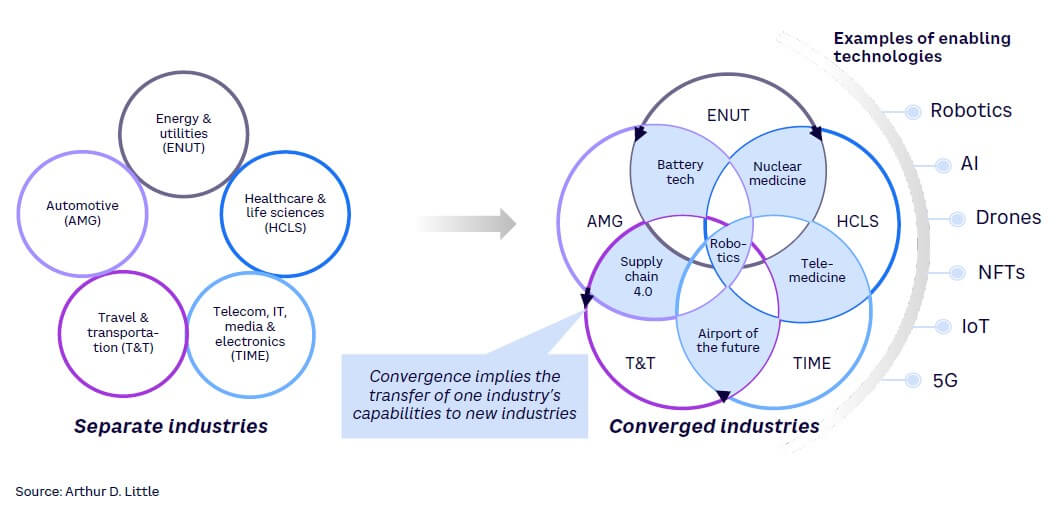
Hardware and technology companies (whether they are manufacturing appliances, cars, or industrial machinery) must find ways to design customer experiences where software and data are at the heart of the offering, or else they risk losing competitiveness over the long term to their digital native competitors. In fact, all companies should regard IT and software development as a highly relevant area to invest heavily in because more than 70% of companies’ software budget is spent on in-house code, according to the Harvard Business Review, and research has shown that industry consolidation is driven in large part by companies that excel in IT and software development. Disruption is almost always caused by clever deployment of IT and technologies (think of Netflix, Uber, and Amazon Web Services [AWS]).
A relevant question to consider is why software has not become a standardized commodity. Primarily, it is because customer and employee software needs vary greatly from company to company. IT and software are dependent on intangible conditions that create requirements that can usually be met only by developing software in-house. Companies such as Netflix, Uber, and Amazon have adopted full-stack business models, where technology is developed in-house and deployed as part of the core offering to customers. To achieve an excellent customer experience, it makes sense for digital leaders to keep IT and technology close to the core. And to avoid being disrupted, incumbent firms must consider the customer and employee experience of their software among their top strategic issues.
Now that we have established the strategic importance, this begs the question: what is a good customer experience of software?
Software customer experience is defined by speed, cost, quality, and customization (see Figure 2). Speed and low-cost or pay-as-you-use models are often the base expectation, while quality and customization (e.g., AWS’s value proposition providing a flexible IT infrastructure solution to millions of companies) are seen as the source of differentiation in the market. Many companies struggle to fulfill all four factors at once, because there are tensions between them. For example, requirements on low cost and high speed tend to result in either low-quality or highly standardized software — poorly fit for purpose. But continuous advancements in the way software gets developed and integrated may have removed this constraint. How do you navigate these requirements today and in the future?
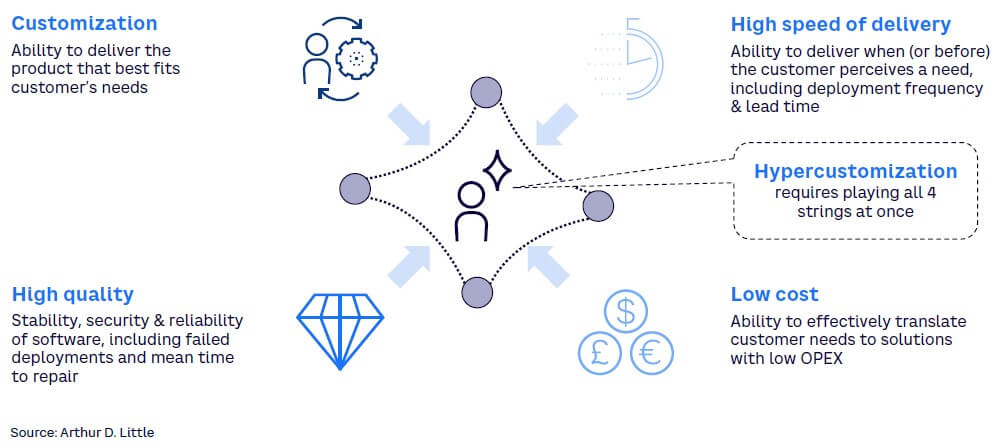
Shift from universal to bespoke solutions: Hypercustomization
Long gone are the days when a company could build one-size-fits-all software that the customers would gladly embrace. Now, companies — and the environments in which they operate — are far more complex and ambiguous, driving the need for customized solutions. As customers’ needs and requirements have changed, the software industry has quickly adapted but the incumbent players in many industries are struggling.
New tools and technologies such as code-writing artificial intelligence (AI), low-code/no-code (LC/NC) platforms such as Mendix and Power Apps, and cloud-native microservices enable companies to build apps much more cost-effectively and in-house and that better fit their needs. The monoliths of old (e.g., integrated ERP systems) are gradually being replaced by an ecosystem of smaller, nimble apps that work together seamlessly when implemented the right way.
We expect the ongoing developments in customer requirements and technological advances within the software industry to fundamentally change the way organizations develop and use software. Developing high-quality, customized software at speed and low cost requires a new way of managing the software development process.
4 BUSINESS IMPERATIVES OF SOFTWARE DEVELOPMENT
Hyperscalers such as Google and Amazon have taken the customer experience to the next level, resulting in increasing pressure on other software and non-software companies to deliver high-quality customer experiences. Hyperscalers will continue to drive increasing demand for customer experience. Companies must start decoding the what and the how behind the customer experience.
To develop organizations that can excel in delivering customer experience of software (The What: speed, high quality, low cost, and customization), companies should define a coherent strategy looking into four elements (The How: technology, ways of working, people and culture, and organization and collaboration (see Arthur D. Little’s [ADL’s] Software Excellence framework, in Figure 3).
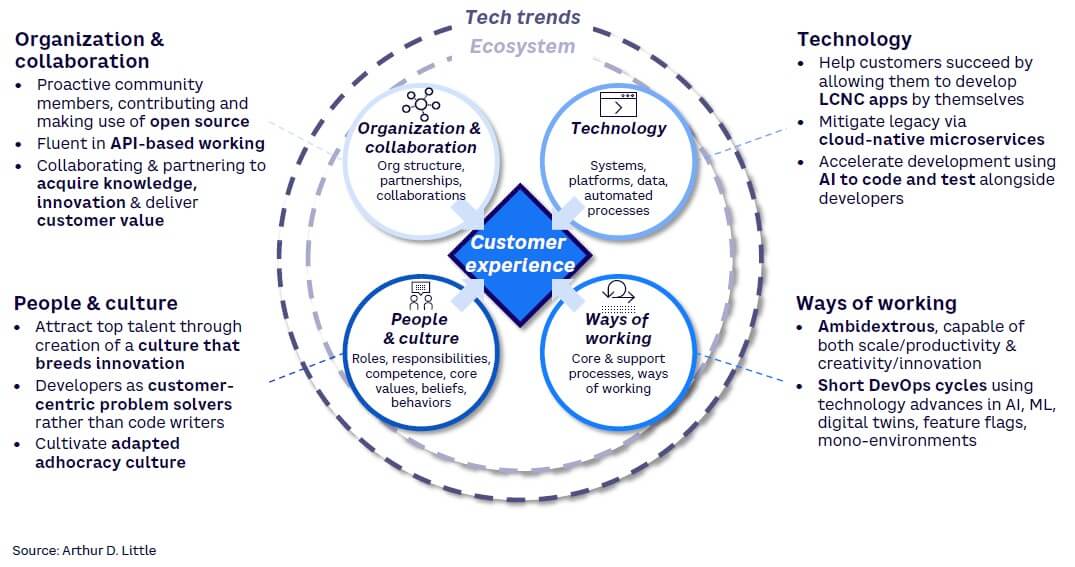
New technology is transforming software development
The technological enablers serve as the backbone of software excellence because having the right technology is a prerequisite to conduct business. Crucial business functions such as strategic planning, analysis, customer engagement, and payments depend on the functioning links between various business systems. However, having access to the latest technology is by no means enough to successfully reach a hypercustomized state. The technological enablers also must be fit for the business problem to be solved and to the maturity level of the organization. Many ingenious technological developments have been developed that will lead the way forward and be instrumental enablers of the future of software. The following tools are, in our view, crucial for all hardware-driven organizations to master and begin using in product offerings and the internal IT landscape.
LC/NC software development
Business users have long been expected to build simple applications; for example, models in Microsoft Excel. However, more advanced applications have required the handiwork of trained software developers. LC/NC platforms were invented as a response to the lack of qualified software engineers. Examples of LC/NC platforms include Microsoft Power Apps, Appian, Mendix, and many others. LC/NC allows business users to program dynamic reports, automatic workflows, and chatbots using a click-and-drag interface.
The simplicity of LC/NC will accelerate the digitalization of companies and free up software developers for more advanced tasks. LC/NC will also bridge the gap between IT and the rest of the business, as business users become “citizen developers” — able to understand and design software fit to business needs. With business users able to develop software, the software will be more customized to solve relevant business problems and can be developed at lower cost and at greater speed.
Cloud-native microservices
Another breakthrough technology that has supported the simplification of software development is cloud-native microservices. Big, clunky monolithic applications (e.g., legacy ERP systems) have kept companies locked into their current IT environments, with little room for changes, let alone for speed. One service company estimated that it would take the company many months — up to a year — to deploy a new product because its IT architecture was too complex and based on inefficient legacy applications. Microservices offer an alternative that enables companies to replace legacy applications piece by piece, release new products and services faster, and develop software that is more resilient to bugs and errors.
Microservices enable organizations to smart stitch applications (developed by business users) together into a smooth IT fabric. A word of caution is that microservices require an organization that can skillfully maintain all the different parts. In fact, for an organization that is not fully ready to adopt microservices, business and IT architecture based on microservices can be counterproductive. ADL has found that development speeds may even drop. The global head of application engineering in a tech startup said this:
“If organizations do not have prior experience of microservices, they just took their problem and multiplied it by 100.
You could have a copy of the same thing, but now instead you have a hundred things that need to communicate with each other.”
However, an organization experienced with DevOps will be able to reap significant benefits from microservices — nearly doubling its deployment frequency (five weeks down to three weeks per deployment, per ADL research; see Figure 4).
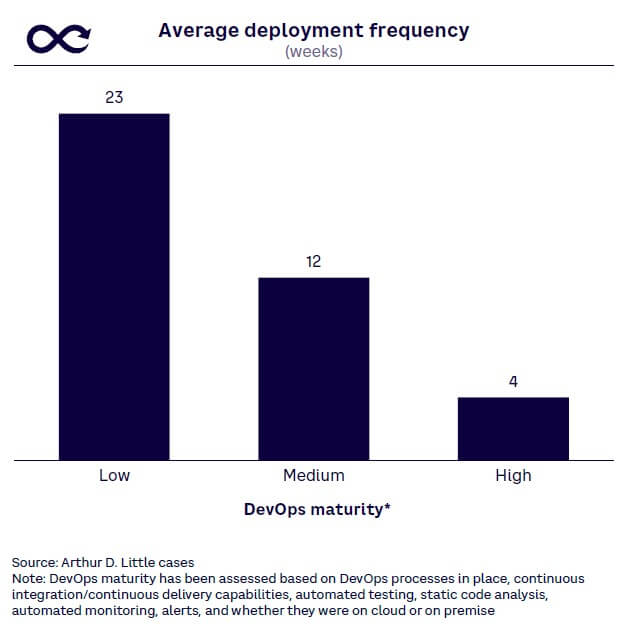
Assistive AI
While AI is often regarded as a buzzword, there are multiple practical use cases of AI in software development. AI can assist coders and citizen developers — business users building their own apps to solve problems in their day-to-day work. Assistive AI will drastically increase the effectiveness and speed of software development, alleviating software developers of many of their redundant tasks so they can focus on the big problems. Furthermore, increased speed of software development will boost the organization in its ability to release new products and services and, by extension, its innovativeness.
An early frontrunner AI-coding tool is GitHub Copilot, which tests developed code and provides suggestions to developers for how they can improve it. Companies that recognize the power of such tools and create workflows that integrate them into their core processes will be able to increase the quality and speed of their delivery.
Tomorrow’s winners will adopt ambidextrous ways of working
To maintain a competitive edge, companies must be “ambidextrous” when bringing new products and technologies to market (exploration) while exploiting existing ones, meaning they continuously balance creativity and innovation with scale and productivity. In software development, this is expressed in an ability to adapt the method you apply depending on the project stage, size, or its complexity. Not all projects are fit for an Agile approach, just as not all projects are suitable for a waterfall approach (see Figure 5). The ability to apply these methods in parallel to respond to a variety of customer needs and to balance innovation with productivity are key features of a successful future-proof organization.
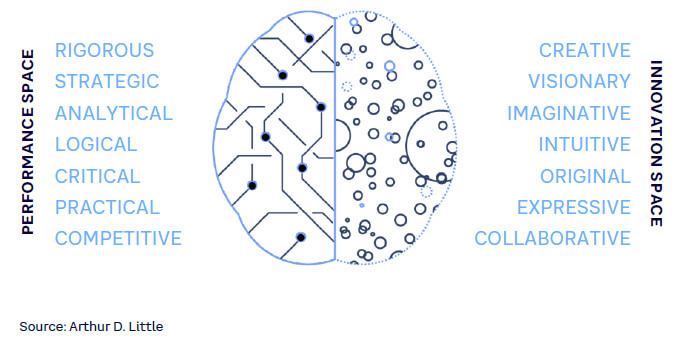
“Adhocracy” leadership in an uncertain and fast-paced world
The importance of building a culture of adhocracy will continue to gain importance within the software development industry. Adhocracy culture focuses on innovation and risk-taking, which will be crucial to keep up with the innovation pace in the industry as well as attract talent. An adhocratic culture encourages autonomy and initiative-taking. Leaders in an adhocracy balance the advantages of strict rigor with intuitive experimentation.
The adhocratic management philosophy has many similarities with successful Silicon Valley startup management philosophies, such as the Lean stand-up, which emphasizes the importance of failing fast to be able to quickly pivot and test the next option. Organizations such as Amazon, Google, Klarna, and others have become very successful in part because they adopted the approach of failing fast. Leading design and innovation consultancy IDEO’s slogan sums it up well: “Fail often in order to succeed sooner.”
The art of empowerment is an age-old leadership principle, which has been popularized by the world’s hyperscalers. Empowerment requires a leadership that knows when to step in and lead the way — and when to back off and let people tap into their own magic to create wonders.
Most of all, people in an organization must feel that they have control of what they do and that they are free to explore and try new ideas. Empowered product teams consist of people within multiple areas of expertise, put together to solve specific problems with the customer experience. The leading software innovators of Silicon Valley have successfully deployed empowered product teams in their organizations, which has enabled them to create the organizational culture needed to succeed with software innovation. Empowered product teams can bridge the gap between organizational siloes and create teams with joint dedicated responsibility for specific challenges.
Build a culture of software innovation
People are at the heart of every innovative company. They are the visionaries and pioneers who produce new ideas to test and discover new customer needs to be solved. To be a best-in-class software developing company, you must have best-in-class people. Netflix’s CEO accredited the company’s success to high talent density, which allowed Netflix to build the high-performing company it is today. Talent is particularly important and scarce in software development. To acquire leading software talent, it is crucial to build a culture that is purpose-driven, with people in the organization intrinsically motivated by the cause at hand. One senior executive at a healthcare AI-software startup said:
“We have been able to attract people from NASA to work for us — because they were genuinely motivated by our purpose to save people’s lives by detecting cancers. And after all, finding clusters of stars in outer space is not so different from finding cancer tumors on skin.”
Furthermore, the organization must attract people with a growth mindset, who learn and develop from both their successes and mistakes. People who enjoy solving problems to continuously grow and develop themselves and their competence, and who do so in an autonomous way — guided by the desire to learn. The way the organization grows is by making sure its people grow, and by disseminating knowledge among them. Having access to a diverse set of skills will grow the joint knowledge base of the organization as people interact and solve problems together.
Leverage partnerships to gain new competences & ideas
Few phenomena have been as frequently cited in the world of business recently as partnerships and ecosystems. Back in 2002, Amazon CEO Jeff Bezos wrote the highly influential API manifesto to his company. The message was simple yet effective: all software in Amazon from thereon would be developed through open APIs. The choice to develop a platform based on open APIs enabled Amazon to become the technology leader that we observe today. Open APIs incentivize partnerships by making it easy for collaborators to create and exchange value on the platform. Open APIs have enabled Amazon to help its partners (retailers) build a business on Amazon’s platform — an exchange of value that significantly benefits both Amazon and its partners, and has helped Amazon build a side business, AWS, which now completely dwarfs Amazon’s e-commerce business revenue.
Other forms of partnerships and ecosystems that will be important to tap into are, for example, developer communities, where companies can get access to the best minds in software. Oftentimes, companies can also make use of — and contribute to — open source code, which enables smaller software developing firms to stand on the shoulders of giants (e.g., IBM, Red Hat), and the giants to gain insight from the world’s visionaries. Topcoder is an example of a talent community that has become crucial to the developer community. It is a software community that organizes 1.5 million software developers to give them a forum where they can collaborate on the toughest software problems and provide expert consultancy services to companies. Another example of an important open source contributor is Stack Overflow, which helps developers and business users to explore open source code to solve specific problems.
Conclusion
SOFTWARE LEADERSHIP REQUIRES NEW MANAGEMENT PARADIGM
With the blurring of industry lines due to convergence, software is becoming an increasingly central part of all companies’ value offerings — those of technology firms, incumbent hardware manufacturers, and digital natives alike. Those organizations that can skillfully develop software and use it as a core part of a data-driven offering will unlock disruptive business models and benefit from increased productivity. Software leaders of the future will achieve the following:
- Excel by delivering high-quality, customizable software at low cost and with frequent deployment.
- Skillfully use technological enablers to simplify and customize software delivery.
- Deploy empowered product teams to solve customer problems.
- Develop a culture of autonomy and empowerment.
- Excel in finding and maintaining fruitful ecosystem collaborations to gain access to outside-in thinking and innovations.
Successfully navigating through industrial convergence will be one of the most challenging tasks of business executives who want their organizations to win. The path will be strewn with organizations that fall by the wayside. The decision is yours: will your organization be another casualty of strategic disruption — or will you be a pathfinder who develops a winning business model for the challenging road ahead?




